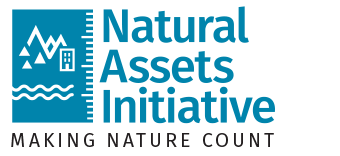A Guidebook for Local Governments: Developing Levels of Service (LOS) for Natural Assets
Local governments in Canada are responsible for providing their citizens and businesses with sustainable, cost-effective services such as transportation, parks and recreation, drinking water, and protection from flooding. Local governments are beginning to understand that natural assets like forests, rivers, lakes, wetlands and parks can make big contributions towards delivering these services, underpin a community’s quality of life, and help meet global challenges like biodiversity protection and building resilience to the impacts of climate change.
Oshawa Creek manages stormwater flows
While local governments are learning more and more about the role natural assets play in service delivery, very few have developed natural asset management strategies and plans to proactively protect and manage natural assets in the way they do for grey infrastructure assets like roads, bridges, water pipes and facilities.
Indeed, many local governments have told MNAI they are challenged with integrating natural asset management into their overall asset management practices and plans that they use for other types of infrastructure.
To help address this challenge, MNAI worked with seven local governments and one Ontario conservation authority to develop a new tool, a guidebook entitled How to Develop Levels of Service for Natural Assets: A Guidebook for Local Governments.
“Natural assets are becoming more and more important for municipalities and we badly needed a better framework to promote the awareness, guidance and management of natural assets. This is a great initiative and well-needed.”
Dharmen Dhaliah, Senior Manager Climate Change & Asset Management,
Town of Halton Hills, ON
Levels of service (LOS) define the expected performance of assets and services and are a fundamental part of asset management planning. Defining LOS measures for natural assets enables local governments to be transparent about the services they expect from natural assets. LOS measures guide the activities the local governments will undertake to protect and manage natural assets and ensure they budget and plan for the long-term financial investments that are needed.
The guidebook is in six sections:
-
- Understanding the concept of levels of service.
- Tips on how to define LOS for natural assets vs. grey infrastructure assets.
- A step-by-step process on how to get started in defining LOS.
- Instruction on how to develop corporate, customer, and technical LOS.
- An overview of how different natural asset types contribute to local government service objectives.
- Case studies from the Town of Gibsons, B.C., and the City of Edmonton, Alta.
“This guidance document will be a great tool to help municipalities get started with natural asset management. I learned just how much there is to consider when developing service levels for natural assets, as well as how important it is to showcase all the different services that natural assets provide in comparison to gray infrastructure.”
Courtney Teliske, Natural Areas Coordinator, City of Edmonton
The guidebook is available for download and sharing [ download ]
MNAI thanks the Neptis Foundation and the Greenbelt Foundation for funding this guidebook project.


